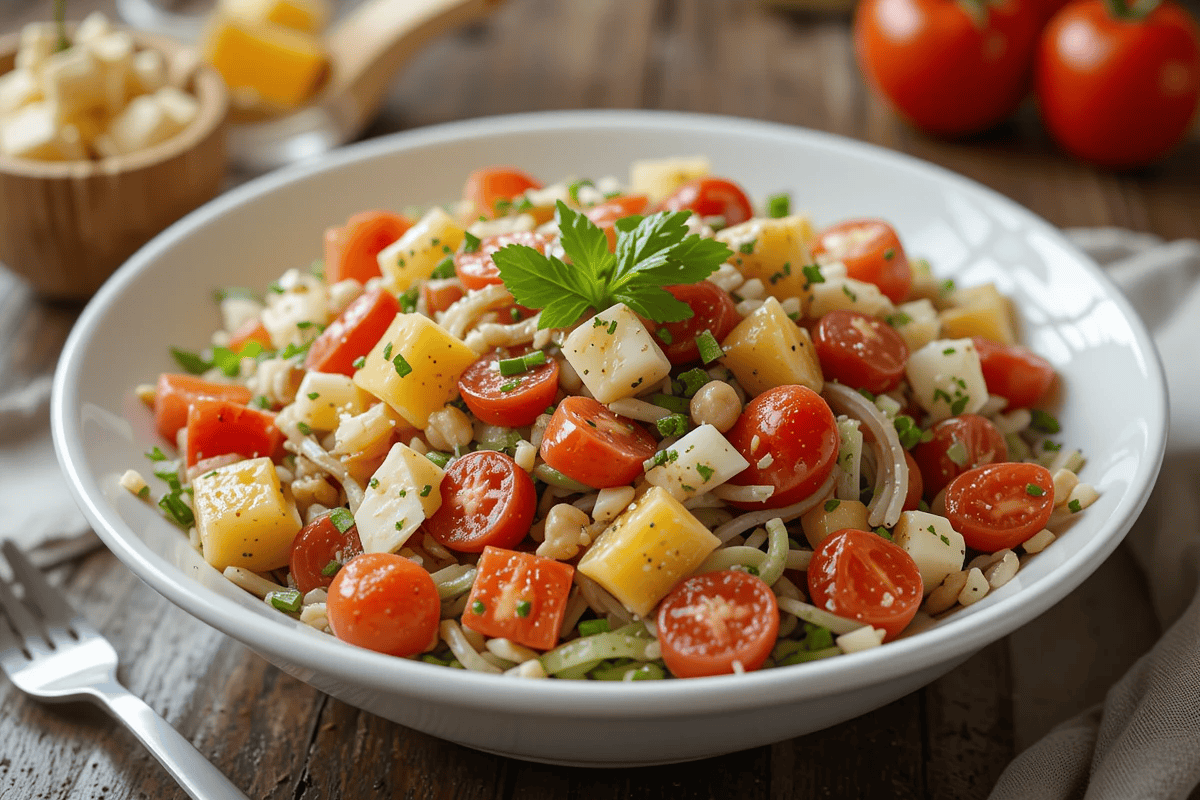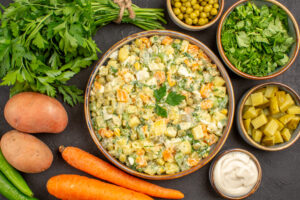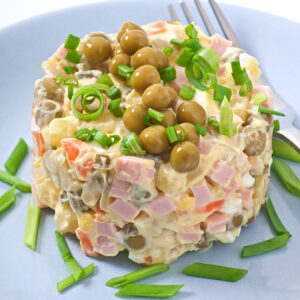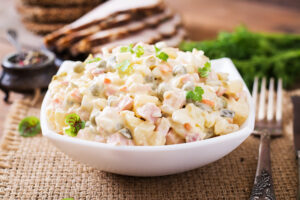Introduction to Classic Russian Salad :
The classic Russian salad, known as Olivier Salad in many regions, is one of the most iconic dishes in Russian cuisine. This beloved dish is a creamy and hearty salad typically made with vegetables, eggs, pickles, meat, and a generous amount of mayonnaise. Over time, this dish has become a staple not just in Russia, but also across many parts of Eastern Europe and other post-Soviet states.
While the Russian salad is often associated with special occasions and holiday feasts, especially New Year’s Eve, its versatility has made it a popular choice year-round. The recipe is flexible, allowing for both traditional and creative variations that make this dish a crowd-pleaser. Whether you’re preparing it for a festive event or as a comforting family meal, the classic Russian salad is a dish that holds a special place in many hearts.
With its creamy texture, vibrant colors, and simple ingredients, the classic Russian salad has proven to be more than just a salad. It’s a part of Russian culture, a symbol of togetherness, and a dish that brings families and friends together to celebrate life’s special moments.
Historical Origins of Russian Salad
The classic Russian salad has an intriguing history that dates back to the 19th century. It was first created in 1860 by the French chef Lucien Olivier, who worked at the prestigious Hermitage restaurant in Moscow. Olivier’s original recipe was luxurious, incorporating rare and expensive ingredients such as lobster, caviar, and smoked duck. The salad became an instant hit among the Russian aristocracy, who could afford such extravagances.
As time passed, the recipe underwent numerous changes, especially as the dish became more accessible to the general population. In the Soviet era, the salad was adapted to fit the more modest ingredients available. The lavish seafood and meats of the original recipe were replaced with simpler, more affordable options like boiled chicken, bologna, and vegetables. Despite these changes, the core components of the salad – vegetables, meat, and mayonnaise – remained largely unchanged.
Over the years, the classic Russian salad has evolved into a staple of everyday Russian cuisine, as well as a symbol of celebration. It’s commonly served during the New Year’s holiday, and many households still include it in their festive spreads. This humble dish has come a long way from its aristocratic origins, yet it continues to bring joy to countless people across the world. For more detailed information on Lucien Olivier’s history, you can explore his story further in the Wikipedia page on Lucien Olivier.
The salad’s versatility and widespread popularity can also be attributed to its use of common, inexpensive ingredients that are easy to find and store. As a result, the dish quickly became a favorite in Soviet kitchens, where it was often prepared in large quantities for family gatherings, holidays, and celebrations.
Cultural Significance
In Russia and other former Soviet republics, the classic Russian salad has become synonymous with holidays and celebrations. The most notable occasion for serving this dish is New Year’s Eve, when families gather around the table to share a meal and celebrate the coming year. During this time, the salad is often accompanied by other traditional Russian dishes, such as herring under a fur coat (a layered salad made with herring, vegetables, and mayonnaise), and pelmeni (dumplings).
The dish has a deep cultural significance, as it represents abundance, family, and togetherness. In fact, it’s almost impossible to imagine a Russian holiday spread without the classic Russian salad making an appearance. It is also common to serve the salad at weddings, birthdays, and other major events, making it an essential part of many life celebrations.
Interestingly, the Russian salad is known by different names and variations across different countries. In Armenia, for example, it is known as Olivier Salad, while in Ukraine, a variation of the salad often includes apples for added sweetness. In many countries, the salad has become a symbol of Soviet nostalgia, with different generations of people coming together to share the same dish that has been passed down from their grandparents. To learn more about different Russian holiday salads, including Vinegret and Herring under a Fur Coat, you can visit the Vinegret Wikipedia page.
Traditional Ingredients of Russian Salad
The charm of the classic Russian salad lies in its simplicity. Despite its creamy dressing and rich flavors, the ingredients are mostly common, everyday items that are easy to prepare. Here’s a closer look at the ingredients that define the traditional Russian salad:
- Boiled Potatoes: Potatoes serve as the primary starch in the salad and provide a solid base. They should be boiled until tender but firm enough to hold their shape when diced.
- Carrots: Like the potatoes, carrots are boiled and chopped into small pieces. They add a subtle sweetness and vibrant color to the salad.
- Eggs: Hard-boiled eggs are chopped into small pieces and mixed in with the vegetables. They add richness and creaminess to the dish.
- Pickles: The distinctive tang of pickles is a key element of the classic Russian salad. Dill pickles are most commonly used, but some variations may use sweet pickles or other types.
- Green Peas: These are added for a pop of color and a slight sweetness, which balances the richness of the mayo.
- Meat: The meat is typically boiled chicken, bologna, or ham. It can be substituted with other types of meat depending on availability and taste preferences.
- Mayonnaise: Mayonnaise is the essential dressing that brings all the ingredients together. It adds a rich, creamy texture and binds the salad together. Some people prefer a lighter version using low-fat mayonnaise, while others stick to the classic recipe.
In some regional variations, additional ingredients like apples, corn, or even cheese are included to introduce new textures and flavors. These variations make the dish even more versatile and open to customization.
Preparation Methods for Classic Russian Salad
Preparing the classic Russian salad is a straightforward process, but achieving the perfect balance of textures and flavors requires some attention to detail. Here’s how to make this iconic dish:
Step 1: Cook the Vegetables
- Begin by boiling the potatoes and carrots. Make sure to cook them until they are tender but still firm enough to hold their shape when chopped.
- After boiling, allow them to cool before dicing them into small cubes. This ensures that the salad will have the right texture and prevents the ingredients from becoming mushy.
Step 2: Hard-Boil the Eggs
- Hard-boil the eggs and chop them into small pieces. Eggs add creaminess and richness to the salad, balancing the crunchy vegetables and tangy pickles.
Step 3: Dice the Meats
- Dice your choice of meat (chicken or bologna) into small cubes. For a more luxurious version, you can add additional meats like ham or turkey. Some variations of the salad also omit meat entirely for a vegetarian version.
Step 4: Mix the Vegetables and Meats
- In a large mixing bowl, combine the diced potatoes, carrots, eggs, pickles, green peas, and meats. Gently toss the ingredients together to mix them evenly. Be careful not to over-mix or crush the ingredients.
Step 5: Add the Mayonnaise
- Add mayonnaise to the salad. Stir gently to coat all the ingredients evenly. Adjust the amount of mayo based on your preference for creaminess. If you prefer a lighter salad, you can substitute some of the mayo with sour cream or yogurt.
Step 6: Season the Salad
- Taste the salad and add salt and pepper to taste. Some people also like to add a dash of mustard to the salad for extra flavor. Be sure to season to your liking and adjust the flavors as needed.
Step 7: Chill and Serve
- For the best results, allow the salad to chill in the refrigerator for at least an hour before serving. This allows the flavors to meld together and enhances the overall taste of the dish.
Variations and Modern Adaptations
While the classic Russian salad is already delicious in its traditional form, there are many variations that cater to different tastes and dietary preferences. Here are some popular adaptations:
Vegetarian Versions
- If you’re looking for a vegetarian option, simply substitute the meat with extra vegetables or tofu. You can add ingredients like sweet corn, apples, or olives to enhance the salad’s flavor and texture.
Healthier Versions
- For a healthier take on the Russian salad, consider using low-fat mayonnaise or replacing the mayo with yogurt or sour cream. You can also reduce the quantity of mayo to make the salad lighter.
Regional Variations
- Some regions add additional ingredients like apples, cheese, or corn. These variations give the salad a distinct flavor and make it even more versatile for different palates.
Serving Suggestions for Classic Russian Salad
Once you’ve made the classic Russian salad, presentation is important. Here are some tips for serving:
- Traditional Serving: The salad is traditionally served chilled in a large bowl or platter. You can garnish it with fresh herbs like parsley or dill to add color and flavor.
- Individual Portions: For an elegant presentation, serve the salad in individual portions, such as in small bowls or cocktail glasses.
- Accompaniments: The Russian salad pairs well with fresh bread, crackers, or other appetizers. It can also be served as a side dish alongside roasted meats or other main courses.
Pairing Classic Russian Salad with Other Dishes
The classic Russian salad is a versatile dish that can be paired with a variety of other foods to create a complete meal. Here are some ideas:
- Main Courses: Serve the salad as a side dish with roasted meats, grilled chicken, or fish. It also complements dishes like stuffed chicken breasts or grilled sausages.
- Breads and Crackers: Serve the salad with freshly baked bread, buttered rolls, or crispy crackers for added texture and crunch.
- Beverages: A glass of sparkling wine, white wine, or even iced tea can complement the flavors of the Russian salad without overpowering it.
Frequently Asked Questions (FAQs)
1. What is the difference between Russian salad and Olivier salad?
- There is no difference between the two. Olivier salad is simply the name given to Russian salad in many regions, particularly in Armenia and Ukraine. Both names refer to the same dish, made with similar ingredients and dressed with mayonnaise.
2. Can I make Russian salad ahead of time?
- Yes, you can prepare Russian salad in advance and store it in the refrigerator for up to 2-3 days. This allows the flavors to develop and blend together. Just be sure to keep it tightly covered to prevent it from absorbing any odors from the fridge.
3. What can I substitute for mayonnaise in Russian salad?
- If you’re looking for a lighter or healthier alternative, you can use Greek yogurt, sour cream, or a vinaigrette dressing instead of mayonnaise. These options can help reduce the richness of the salad while still keeping it creamy.
You can enhance the nutritional value of your salads by exploring other healthy options like quinoa fruit salad. This vibrant and nutritious dish combines quinoa with fresh fruits, making it a great alternative for those who want a lighter, yet filling option. Check out this Quinoa Fruit Salad recipe for a delightful and healthy twist on your usual salad choices.
Conclusion
The classic Russian salad is a dish that has stood the test of time, evolving from an aristocratic delicacy to a beloved staple in Russian and Eastern European households. Its simplicity, versatility, and creamy texture make it a perfect addition to any meal or celebration. Whether you’re sticking to the traditional recipe or experimenting with your own variations, this salad will always remain a symbol of warmth, family, and festive cheer.





